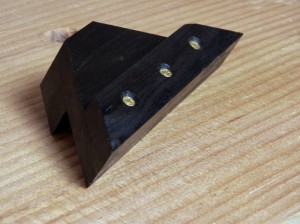Miter Paring Block from Ebony
A few weeks ago, I published a quick video about using wood scraps as practice pieces to improve your sawing and/or planing skills. I hope it goes without saying that I am only cutting up the pieces that I know I either won’t need or have plenty of the same species floating around that I won’t miss the scrap. At the same time, if the scrap in question is of a valuable species, I will save every last inch. In face the irony is that the smaller the scrap the more likely it is that it will get saved. Members of The Hand Tool School can attest that I have a drawer in my shop that I often will pluck out just the perfect piece of exotic to wedge a tenon or peg a joint. When I “purposely” cut a tenon too loose (for demonstration purposes of course), out comes a little square of wood that I glue back on to the anorexic cheek before re-cutting the tenon. The shim I use to adjust the cutting width of my dado plane is of quartersawn beech and it came from the same drawer. There are 1001 times when you need a little piece of something while working on a project and not having to break down a larger board to get that tiny piece is a huge time saver. When you can use that tiny piece as a design element by substituting in a cool exotic, all the better.
So this weekend when I needed to build a small miter paring block, I could have built it from the hunk of Home Depot Poplar sitting at the front of my lumber rack but instead I consulted the scrap drawer. Now my choices were Quilted Maple, Spalted Hornbeam, Curly Claro Walnut, Quartersawn Grenadillo, Ziracote, Quartersawn White Oak, and Macassar Ebony. I love this scrap drawer!
 It’s a funny side effect of selling off my power tools, but I find that even the little shop aids I build get the royal treatment. You see it takes the same amount of effort and time to build a miter block by hand no matter what species you use. I might as well use up some of this scrap and make this simple gauge an heirloom tool. So finally after about 7 years this little hunk of Macassar Ebony has found a home. And not an inch of it went to waste. When I sawed out the large rabbet, I adhered that fall off piece to the front as a grip to help me hold the paring block firmly in place while in use. It was glued in place firmly but why not sweeten the deal with some brass screws? In the end, I have a paring block that will make me smile each time I use it, and it is well made enough that it just might show up at an antique sale 300 years from now.
It’s a funny side effect of selling off my power tools, but I find that even the little shop aids I build get the royal treatment. You see it takes the same amount of effort and time to build a miter block by hand no matter what species you use. I might as well use up some of this scrap and make this simple gauge an heirloom tool. So finally after about 7 years this little hunk of Macassar Ebony has found a home. And not an inch of it went to waste. When I sawed out the large rabbet, I adhered that fall off piece to the front as a grip to help me hold the paring block firmly in place while in use. It was glued in place firmly but why not sweeten the deal with some brass screws? In the end, I have a paring block that will make me smile each time I use it, and it is well made enough that it just might show up at an antique sale 300 years from now.
By the way, this block would have been made faster in any other species. Dang that Ebony is hard stuff!



